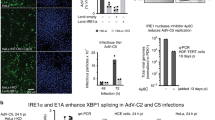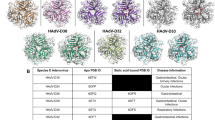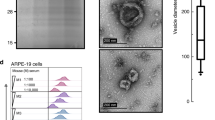Abstract
Human CD46 (membrane cofactor protein), which serves as a receptor for a variety of pathogens, including strains of measles virus, human herpesvirus type 6 and Neisseria, is rapidly downregulated from the cell surface following infection by these pathogens. Here, we report that replication-incompetent adenovirus (Ad) serotype 35 (Ad35) vectors, which belong to subgroup B and recognize human CD46 as a receptor, downregulate CD46 following infection. A decline in the surface expression of CD46 in human peripheral blood mononuclear cells was detectable 6 h after infection, and reached maximum (72%) 12 h after infection. Ad35 vector-induced downregulation of surface CD46 levels gradually recovered after the removal of Ad35 vectors, however, complete recovery of CD46 expression was not observed even at 96 h after removal. The surface expression of CD46 was also reduced after incubation with fiber-substituted Ad serotype 5 (Ad5) vectors bearing Ad35 fiber proteins, ultraviolet-irradiated Ad35, vectors and recombinant Ad35 fiber knob proteins; in contrast, conventional Ad5 vectors did not induce surface CD46 downregulation, suggesting that the fiber knob protein of Ad35 plays a crucial role in the downregulation of surface CD46 density. These results have important implications for gene therapy using CD46-utilizing Ad vectors and for the pathogenesis of Ads that interact with CD46.
This is a preview of subscription content, access via your institution
Access options
Subscribe to this journal
Receive 12 print issues and online access
$259.00 per year
only $21.58 per issue
Buy this article
- Purchase on Springer Link
- Instant access to full article PDF
Prices may be subject to local taxes which are calculated during checkout




Similar content being viewed by others
Abbreviations
- Ad:
-
adenovirus
- APC:
-
allophycocyanin
- BSA:
-
bovine serum albumin
- CAR:
-
coxsackievirus and adenovirus receptor
- FBS:
-
fetal bovine serum
- FITC:
-
fluorescein isothiocyanate
- GAPDH:
-
glyceraldehyde-3-phosphate dehydrogenase
- GFP:
-
green fluorescence protein
- HHV6:
-
herpesvirus type 6
- MV:
-
measles virus
- MVH:
-
measles virus hemagglutinin
- MFI:
-
mean fluorescence intensity
- MOI:
-
multiplicity of infection
- PBMCs:
-
peripheral blood mononuclear cells
- PBS:
-
phosphate-buffered saline
- RT-PCR:
-
reverse transcriptase-polymerase chain reaction
- SCRs:
-
short consensus repeats
- VP:
-
vector particle
- PE:
-
phycoerythrin.
References
Liszewski MK, Post TW, Atkinson JP . Membrane cofactor protein (MCP or CD46): newest member of the regulators of complement activation gene cluster. Annu Rev Immunol 1991; 9: 431–455.
Seya T, Atkinson JP . Functional properties of membrane cofactor protein of complement. Biochem J 1989; 264: 581–588.
Dorig RE, Marcil A, Chopra A, Richardson CD . The human CD46 molecule is a receptor for measles virus (Edmonston strain). Cell 1993; 75: 295–305.
Santoro F, Kennedy PE, Locatelli G, Malnati MS, Berger EA, Lusso P . CD46 is a cellular receptor for human herpesvirus 6. Cell 1999; 99: 817–827.
Rezcallah MS, Hodges K, Gill DB, Atkinson JP, Wang B, Cleary PP . Engagement of CD46 and alpha5beta1 integrin by group A streptococci is required for efficient invasion of epithelial cells. Cell Microbiol 2005; 7: 645–653.
Kallstrom H, Liszewski MK, Atkinson JP, Jonsson AB . Membrane cofactor protein (MCP or CD46) is a cellular pilus receptor for pathogenic Neisseria. Mol Microbiol 1997; 25: 639–647.
Naniche D, Wild TF, Rabourdin-Combe C, Gerlier D . Measles virus haemagglutinin induces down-regulation of gp57/67, a molecule involved in virus binding. J Gen Virol 1993; 74 (Part 6): 1073–1079.
Schneider-Schaulies J, Dunster LM, Kobune F, Rima B, ter Meulen V . Differential downregulation of CD46 by measles virus strains. J Virol 1995; 69: 7257–7259.
Gill DB, Koomey M, Cannon JG, Atkinson JP . Down-regulation of CD46 by piliated Neisseria gonorrhoeae. J Exp Med 2003; 198: 1313–1322.
Schnorr JJ, Dunster LM, Nanan R, Schneider-Schaulies J, Schneider-Schaulies S, ter Meulen V . Measles virus-induced down-regulation of CD46 is associated with enhanced sensitivity to complement-mediated lysis of infected cells. Eur J Immunol 1995; 25: 976–984.
Gaggar A, Shayakhmetov DM, Lieber A . CD46 is a cellular receptor for group B adenoviruses. Nat Med 2003; 9: 1408–1412.
Segerman A, Atkinson JP, Marttila M, Dennerquist V, Wadell G, Arnberg N . Adenovirus type 11 uses CD46 as a cellular receptor. J Virol 2003; 77: 9183–9191.
Fleischli C, Verhaagh S, Havenga M, Sirena D, Schaffner W, Cattaneo R et al. The distal short consensus repeats 1 and 2 of the membrane cofactor protein CD46 and their distance from the cell membrane determine productive entry of species B adenovirus serotype 35. J Virol 2005; 79: 10013–10022.
Gaggar A, Shayakhmetov DM, Liszewski MK, Atkinson JP, Lieber A . Localization of regions in CD46 that interact with adenovirus. J Virol 2005; 79: 7503–7513.
Sakurai F, Murakami S, Kawabata K, Okada N, Yamamoto A, Seya T et al. The short consensus repeats 1 and 2, not the cytoplasmic domain, of human CD46 are crucial for infection of subgroup B adenovirus serotype 35. J Control Release 2006; 113: 271–278.
Wild TF, Buckland R . Functional aspects of envelope-associated measles virus proteins. Curr Top Microbiol Immunol 1995; 191: 51–64.
Schneider-Schaulies J, Schnorr JJ, Brinckmann U, Dunster LM, Baczko K, Liebert UG et al. Receptor usage and differential downregulation of CD46 by measles virus wild-type and vaccine strains. Proc Natl Acad Sci USA 1995; 92: 3943–3947.
Vogels R, Zuijdgeest D, van Rijnsoever R, Hartkoorn E, Damen I, de Bethune MP et al. Replication-deficient human adenovirus type 35 vectors for gene transfer and vaccination: efficient human cell infection and bypass of preexisting adenovirus immunity. J Virol 2003; 77: 8263–8271.
Roelvink PW, Lizonova A, Lee JG, Li Y, Bergelson JM, Finberg RW et al. The coxsackievirus-adenovirus receptor protein can function as a cellular attachment protein for adenovirus serotypes from subgroups A, C, D, E, and F. J Virol 1998; 72: 7909–7915.
Sakurai F, Mizuguchi H, Hayakawa T . Efficient gene transfer into human CD34+ cells by an adenovirus type 35 vector. Gene Therapy 2003; 10: 1041–1048.
Seshidhar Reddy P, Ganesh S, Limbach MP, Brann T, Pinkstaff A, Kaloss M et al. Development of adenovirus serotype 35 as a gene transfer vector. Virology 2003; 311: 384–393.
Abrahamsen K, Kong HL, Mastrangeli A, Brough D, Lizonova A, Crystal RG et al. Construction of an adenovirus type 7a E1A- vector. J Virol 1997; 71: 8946–8951.
Holterman L, Vogels R, van der Vlugt R, Sieuwerts M, Grimbergen J, Kaspers J et al. Novel replication-incompetent vector derived from adenovirus type 11 (Ad11) for vaccination and gene therapy: low seroprevalence and non-cross-reactivity with Ad5. J Virol 2004; 78: 13207–13215.
Sirena D, Ruzsics Z, Schaffner W, Greber UF, Hemmi S . The nucleotide sequence and a first generation gene transfer vector of species B human adenovirus serotype 3. Virology 2005; 343: 283–298.
Mizuguchi H, Hayakawa T . Adenovirus vectors containing chimeric type 5 and type 35 fiber proteins exhibit altered and expanded tropism and increase the size limit of foreign genes. Gene 2002; 285: 69–77.
Shayakhmetov DM, Papayannopoulou T, Stamatoyannopoulos G, Lieber A . Efficient gene transfer into human CD34(+) cells by a retargeted adenovirus vector. J Virol 2000; 74: 2567–2583.
Krasnykh VN, Mikheeva GV, Douglas JT, Curiel DT . Generation of recombinant adenovirus vectors with modified fibers for altering viral tropism. J Virol 1996; 70: 6839–6846.
Stecher H, Shayakhmetov DM, Stamatoyannopoulos G, Lieber A . A capsid-modified adenovirus vector devoid of all viral genes: assessment of transduction and toxicity in human hematopoietic cells. Mol Ther 2001; 4: 36–44.
Karp CL, Wysocka M, Wahl LM, Ahearn JM, Cuomo PJ, Sherry B et al. Mechanism of suppression of cell-mediated immunity by measles virus. Science 1996; 273: 228–231.
Smith A, Santoro F, Di Lullo G, Dagna L, Verani A, Lusso P . Selective suppression of IL-12 production by human herpesvirus 6. Blood 2003; 102: 2877–2884.
Schneider-Schaulies J, Schnorr JJ, Schlender J, Dunster LM, Schneider-Schaulies S, ter Meulen V . Receptor (CD46) modulation and complement-mediated lysis of uninfected cells after contact with measles virus-infected cells. J Virol 1996; 70: 255–263.
Lecouturier V, Rizzitelli A, Fayolle J, Daviet L, Wild FT, Buckland R . Interaction of measles virus (Halle strain) with CD46: evidence that a common binding site on CD46 facilitates both CD46 downregulation and MV infection. Biochem Biophys Res Commun 1999; 264: 268–275.
Iwata K, Seya T, Yanagi Y, Pesando JM, Johnson PM, Okabe M et al. Diversity of sites for measles virus binding and for inactivation of complement C3b and C4b on membrane cofactor protein CD46. J Biol Chem 1995; 270: 15148–15152.
Manchester M, Valsamakis A, Kaufman R, Liszewski MK, Alvarez J, Atkinson JP et al. Measles virus and C3 binding sites are distinct on membrane cofactor protein (CD46). Proc Natl Acad Sci USA 1995; 92: 2303–2307.
Bartz R, Firsching R, Rima B, ter Meulen V, Schneider-Schaulies J . Differential receptor usage by measles virus strains. J Gen Virol 1998; 79 (Part 5): 1015–1025.
Liszewski MK, Tedja I, Atkinson JP . Membrane cofactor protein (CD46) of complement. Processing differences related to alternatively spliced cytoplasmic domains. J Biol Chem 1994; 269: 10776–10779.
Oliaro J, Pasam A, Waterhouse NJ, Browne KA, Ludford-Menting MJ, Trapani JA et al. Ligation of the cell surface receptor, CD46, alters T cell polarity and response to antigen presentation. Proc Natl Acad Sci USA 2006; 103: 18685–18690.
Kemper C, Verbsky JW, Price JD, Atkinson JP . T-cell stimulation and regulation: with complements from CD46. Immunol Res 2005; 32: 31–43.
Harris CL, Spiller OB, Morgan BP . Human and rodent decay-accelerating factors (CD55) are not species restricted in their complement-inhibiting activities. Immunology 2000; 100: 462–470.
Sakurai F, Kawabata K, Koizumi N, Yamaguchi T, Hayakawa T, Mizuguchi H . Adenovirus serotype 35 vector-mediated transduction into human CD46-transgenic mice. Gene Therapy 2006; 13: 1118–1126.
Mizuguchi H, Koizumi N, Hosono T, Utoguchi N, Watanabe Y, Kay MA et al. A simplified system for constructing recombinant adenoviral vectors containing heterologous peptides in the HI loop of their fiber knob. Gene Therapy 2001; 8: 730–735.
Maizel Jr JV, White DO, Scharff MD . The polypeptides of adenovirus. I. Evidence for multiple protein components in the virion and a comparison of types 2, 7A, and 12. Virology 1968; 36: 115–125.
Koizumi N, Mizuguchi H, Hosono T, Ishii-Watabe A, Uchida E, Utoguchi N et al. Efficient gene transfer by fiber-mutant adenoviral vectors containing RGD peptide. Biochim Biophys Acta 2001; 1568: 13–20.
Sakurai F, Kawabata K, Yamaguchi T, Hayakawa T, Mizuguchi H . Optimization of adenovirus serotype 35 vectors for efficient transduction in human hematopoietic progenitors: comparison of promoter activities. Gene Therapy 2005; 12: 1424–1433.
Rushmere NK, Knowlden JM, Gee JM, Harper ME, Robertson JF, Morgan BP et al. Analysis of the level of mRNA expression of the membrane regulators of complement, CD59, CD55 and CD46, in breast cancer. Int J Cancer 2004; 108: 930–936.
Dash S, Saxena R, Myung J, Rege T, Tsuji H, Gaglio P et al. HCV RNA levels in hepatocellular carcinomas and adjacent non-tumorous livers. J Virol Methods 2000; 90: 15–23.
Acknowledgements
We thank Ms Naoko Funakoshi, Ms Tomomi Sasaki and Ms Noriko Tada for their technical assistance. We also thank Dr Tsukasa Seya (Hokkaido University, Japan) for providing anti-CD46 rabbit serum. This work was supported by grants for Health and Labour Sciences Research from the Ministry of Health, Labour, and Welfare of Japan, and by Grants-in-Aid for Scientific Research on Priority Areas (B).
Author information
Authors and Affiliations
Corresponding author
Rights and permissions
About this article
Cite this article
Sakurai, F., Akitomo, K., Kawabata, K. et al. Downregulation of human CD46 by adenovirus serotype 35 vectors. Gene Ther 14, 912–919 (2007). https://doi.org/10.1038/sj.gt.3302946
Received:
Revised:
Accepted:
Published:
Issue Date:
DOI: https://doi.org/10.1038/sj.gt.3302946
Keywords
This article is cited by
-
Efficient detection of human circulating tumor cells without significant production of false-positive cells by a novel conditionally replicating adenovirus
Molecular Therapy - Methods & Clinical Development (2016)
-
CD46 Plasticity and Its Inflammatory Bias in Multiple Sclerosis
Archivum Immunologiae et Therapiae Experimentalis (2011)



